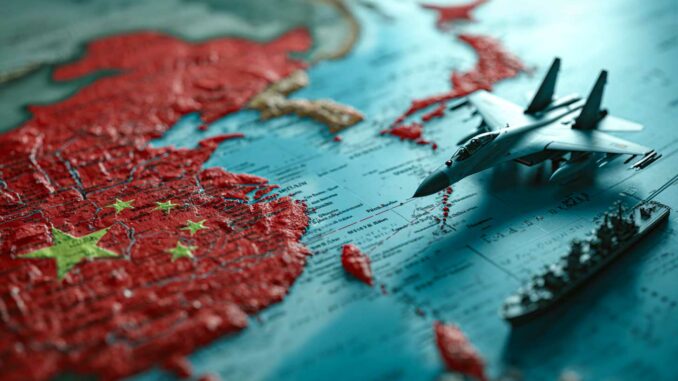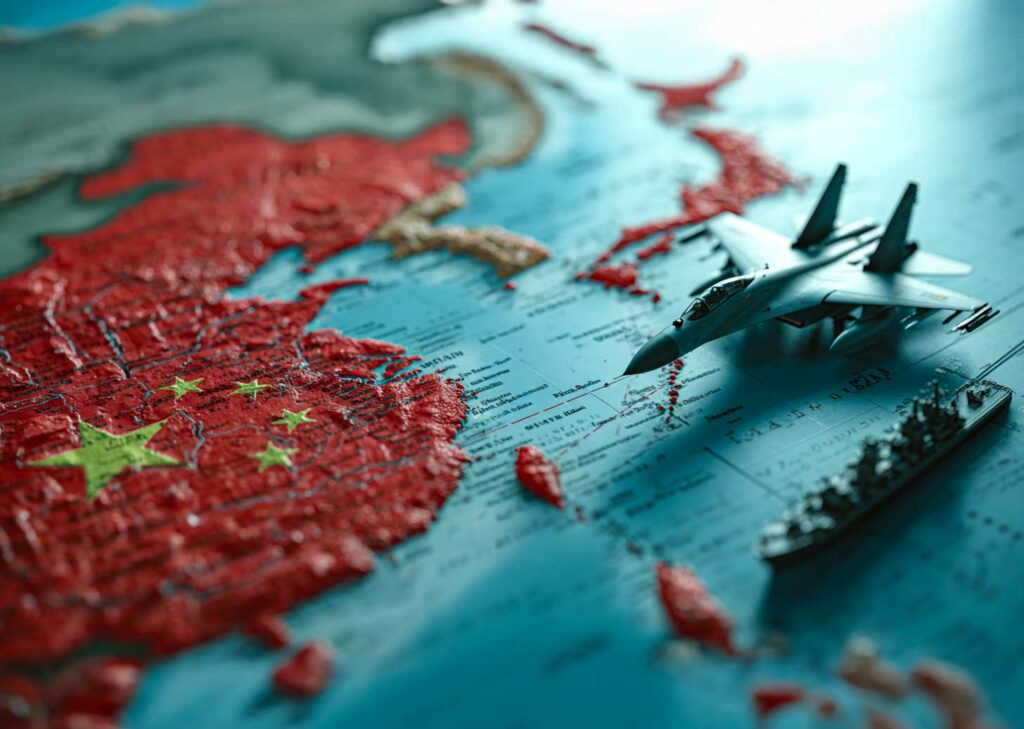
The PLAAF and Chinese navy conducted a joint patrol with 18 fighter jets around Taiwan, their first demonstration since the election.
Summary
China deployed 18 fighter jets and several surface vessels around Taiwan in a joint patrol involving the PLAAF and the PLAN. This operation, which took place after the Taiwanese presidential election, illustrates Beijing‘s desire to exert constant pressure on the island. The aircraft involved – J-16, J-10C, Y-8 and KJ-500 – crossed the median line of the strait and flew into Taiwan’s air identification zone. On the maritime side, Type 054A frigates and a Type 052D destroyer completed the deployment. Taipei responded by deploying fighter jets and surface-to-air defence systems. Washington, Tokyo and the European Union called for restraint. This episode shows how Beijing combines military pressure, political deterrence and diplomatic signals in its strategy of graduated control of the strait.
The nature of the patrol: a coordinated air-sea demonstration
The Taiwanese Ministry of Defence reported the detection of 18 fighter jets and six Chinese navy vessels on the morning of 20 January 2025, three days after the official announcement of the new president-elect in Taipei. The Chinese Air Force (PLAAF) and Navy (PLAN) conducted what is described as a ‘joint combat readiness patrol,’ a specific term used by the Chinese command to refer to joint operational exercises.
The aircraft identified included twelve J-16 multi-role fighters, four J-10C fighters, one Y-8 EW electronic warfare aircraft, and one KJ-500 command and early warning aircraft. Several crossed the median line of the Taiwan Strait — a de facto border separating areas of influence — to briefly enter Taiwan’s Air Defence Identification Zone (ADIZ). These incursions took place at altitudes between 4,500 and 9,000 metres, at moderate speeds, indicating a surveillance profile rather than an attack scenario.
At the same time, the Chinese navy deployed two Type 054A class frigates, a Type 052D destroyer and several logistical support vessels. The group operated between the Fujian coast and the Bashi Channel, while a Y-8Q maritime patrol aircraft flew over the East China Sea. This simultaneous air-sea manoeuvre is intended to test joint coordination and Taiwan’s detection and response capabilities in a sensitive post-election context.
The aircraft involved: a representative sample of Chinese power
The J-16, a modernised derivative of the Su-27, is the backbone of China’s strike force. It features AESA radar, digital avionics and extensive air-to-air and air-to-ground capabilities. With a range of approximately 1,500 kilometres and a payload of 8 tonnes, it can cover the entire Taiwan Strait without refuelling. Its combination of agility and radar power makes it a preferred instrument for air coercion missions.
The J-10C, a single-engine light fighter, is used as a fast interceptor and escort aircraft. Its optimised airframe and AESA radar enable medium-range detection while maintaining a smaller radar signature than the J-11 or Su-30. The combination of these two platforms – heavy and light – allows the PLAAF to simulate a combined attack against air and ground targets.
The KJ-500, a detection and command aircraft, is the linchpin of the system. Its rotating dome radar covers a 360-degree field, capable of tracking more than 100 targets simultaneously at a range of over 450 kilometres. It provides tactical management of fighters and relay with naval systems. The Y-8 EW provides jamming capabilities designed to disrupt enemy radars and transmissions.
These platforms, operated simultaneously, reflect a high degree of joint integration. They demonstrate the growing maturity of the PLAAF, which is capable of orchestrating complex operations in coordination with the PLAN, without relying on American or Russian support.
The political context: a message to Taipei and its allies
The patrol comes amid a tense political climate. The Taiwanese elections in January 2025 saw the victory of a candidate who favours maintaining the status quo with Beijing but is committed to the island’s political autonomy. For China, this is a sign of irritation and political deterrence.
These operations have become Beijing’s preferred method of expressing its dissatisfaction without resorting directly to force. Since 2022, the PLAAF’s daily incursions into Taiwan’s ADIZ have increased from 5 to nearly 20 aircraft per day. However, the current manoeuvre is notable for its joint nature and its proximity to the election.
By simultaneously engaging its navy and air force, China wishes to remind Taiwan that it can isolate it on several fronts: to the north via the Fujian coast, to the south via the Bashi Strait, and to the east via the access corridors to the Philippine Sea. This strategy, known as 360-degree pressure, seeks to wear down Taiwan’s surveillance capabilities and keep the island in a state of constant alert.

International reactions: caution and firmness
Taiwan responded by deploying its F-16Vs from bases in Hualien and Taitung, putting its Patriot PAC-3 and Sky Bow III batteries on alert, and issuing radio warnings. The Taiwanese forces did not seek direct interception, favouring surveillance and radar tracking to avoid any incidents.
In Washington, the Pentagon described the operation as ‘irresponsible provocation’, stressing that it ‘does not contribute to regional stability’. American RC-135 Rivet Joint surveillance aircraft and an MQ-4C Triton drone were observed in the Philippine Sea, approximately 200 kilometres from the median line, presumably to collect data on Chinese coordination.
Japan, whose F-15 fighter jets patrol the skies over Okinawa, has noted an increase in Chinese flights in the southern Japanese identification zone. Tokyo reiterated that ‘peace and stability in the Taiwan Strait are essential to regional security.’ The European Union, in a statement from the External Action Service, urged China to ‘refrain from any unilateral action that could alter the status quo’.
These reactions illustrate a constant: the West now views every Chinese military movement around Taiwan as a test of collective will.
The geopolitical impact: a consolidation of the balance of power
Strategically, the patrol marks a turning point in China’s regional projection. It demonstrates the PLAAF’s ability to combine air presence, maritime surveillance and command coordination in an environment saturated with radar and interference. It is also a signal to the United States: Beijing wants to prove that it can maintain constant pressure without crossing the threshold of open confrontation.
For Taiwan, the challenge is twofold: to preserve the credibility of its integrated air defence while avoiding the exhaustion of its pilots and systems. The Taiwanese government has increased its defence budget to 2.6% of GDP for 2025, or around €19 billion, in order to accelerate the acquisition of drones, three-dimensional radars and Hsiung Feng III anti-ship missiles.
On the American side, this ramp-up reinforces the justification for military assistance and recent arms sales, notably the F-16 Block 70 and AGM-88 HARM missiles. For Beijing, these deployments are a reminder of its determination to challenge any Western militarisation of the strait, relying on a strategy of sustained patrols that combine psychological deterrence and operational learning.
Towards a gradual militarisation of the strait
The increase in these patrols suggests a structural trend: the normalisation of China’s presence around Taiwan. Beijing is seeking habituation rather than confrontation. By increasing the frequency of joint exercises and the density of flight paths, China is transforming the grey area between peace and conflict into a space of constant tension.
This strategy, described by Chinese analysts as ‘active management of the strait’, allows pressure to be maintained without triggering a major collective reaction. However, it erodes the distinction between military exercises and operational preparedness. Ultimately, the informal air border could lose all meaning, transforming Taiwanese airspace into a zone of permanent friction.
For Western allies, the challenge is no longer just to react, but to anticipate. Each Chinese patrol provides data on coordination, duration and flight profiles. This information is essential for calibrating regional deterrence. The question is no longer whether China will one day cross the median line, but when it will cease to recognise that it still exists.
War Wings Daily is an independant magazine.